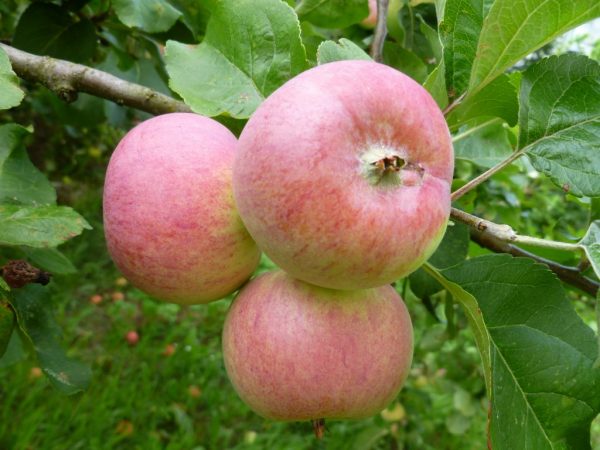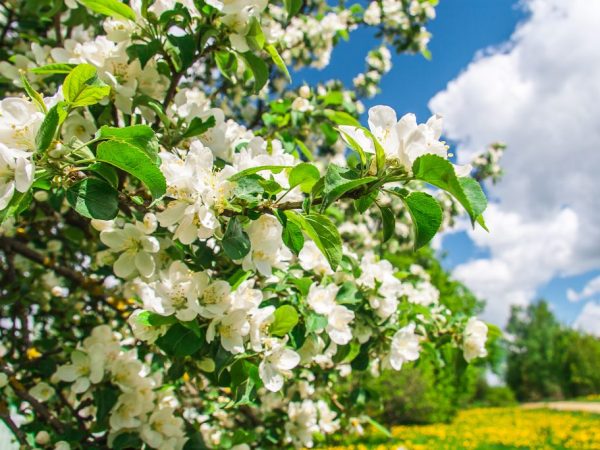Apple variety Grushovka
Everyone's favorite horticultural variety is the Grushovka apple tree. It has been widely known for two centuries and is popular as a versatile fruit plant. It was first described by A. T. Bolotov. Culture has many distinctive qualities for which summer residents love it so much.

Apple variety Grushovka
Advantages and disadvantages
The apple tree Grushovka Moskovskaya has a whole set of positive qualities.
- High index of frost resistance. The plant can withstand severe winters with little rainfall. Due to this feature, it is popular in the northern regions of Russia.
- Possibility to start harvesting in mid-summer when other apple trees are still in maturity.
- 4 years after planting in the ground in a permanent place, the culture gives the first fruits, which characterizes it as early-ripening.
- The high nutritional value of apples with a low calorie content makes them a valuable dietary product.
- High yield rates.
- Long-term fruiting (50-60 years).
There are several drawbacks.
- Exposure to many infectious diseases and pests.
- Uneven ripening of fruits. Above, they begin to ripen faster and gradually fall off, while those below are still green.
- The fruits are not stored for long and cannot be transported.
Description of the variety
Tree and fruit
The tree reaches a height of 6-7 m. The crown has a dense deciduous cover. The branches grow quickly, so timely care is needed for them.
The trunk is strong and well developed to support the weight of skeletal branches and ripe crops. The tree has a lifespan of over 60 years.
The leaves are oblong. Young ones are soft and slightly drooping, while older ones are dense and smooth, sometimes they are found with small teeth at the edges. Petioles are elongated, strong. The light green hue darkens over time.
Grushovka apples of medium size - 120 cm. They are round and slightly flattened. The skin is thin with a rich waxy coating. The color smoothly passes from yellow to light green and is covered with a pink blush on top. In hot summer, the blush is replaced by pink stripes.
Taste
The structure of the pulp is juicy and aromatic, slightly loose. In immature, it has a greenish tint, while in ripe it changes it to a light, creamy one.
The apples are sweet and aromatic. Usually a slight sourness is felt, which indicates a high content of vitamin C. The fruit will be useful for those who follow their figure because with high levels of nutrients, it has a low calorie content.
In overripe fruits, the pulp becomes dry and soft, and during transportation it deteriorates. Unfortunately, the fruit is not suitable for commercial purposes.
Yield

The variety has a good yield.
Compared to other summer apple trees, the Grushovka variety has high yields.
In this case, the variety is considered early: the fruiting period begins at 3-4 years of age. Reaches a peak yield at 15 years (100 kg per tree).
Harvesting takes place in July. Adequate care and rejuvenating pruning allow you to harvest for more than 50 years. In adulthood, alternations with periods of rest are possible.
Pollinators
Self-fertile, like many other species. To ensure the cross appearance of the ovary, it is recommended to plant pollinating plants of 2-3 varieties (Anise striped or Antonovka) within a radius of 50 m.
Winter hardiness
The culture is characterized by extremely high winter hardiness. It can easily withstand low temperatures. Thanks to this feature, gardeners do not have to worry about freezing the trunk.
Damage to fruit buds and branches is minimal, therefore, harsh winters with little snow will not affect the quality and quantity of the future harvest.
A similar high resistance to weather conditions in the cold season and a seedling of this variety.
Disease and pest resistance
The tree does not have natural immunity to fungal diseases, so it can be affected by scab, which can destroy both the fruits and the apple tree itself.
Thinning of the crown and preventive work significantly reduce the risk of this disease. From insects - most often suffers from a weevil.
Growing regions
In the choice of climate, Moskovskaya Grushovka is completely unpretentious: the apple tree withstands cold and frost, is less adapted to droughts during the hot summer, but with sufficient watering, the vegetation process is not disturbed.
Can be found not only in Russia. It found a place in Western countries, on the territory of Ukraine, Belarus, the Urals and eastern Siberia.
Landing

Apple trees need sunlight
The best time to plant is early spring, after the start of the growing season (April). You can carry out the procedure in the fall, in October.
The tree does not like drafts and strong gusts of wind. Prefers southern slopes.
- The planting pit (1 m depth, 60 cm diameter) is prepared in a few weeks. A third of the soil is mixed with a bucket of compost and, poured back, forms a hill. Cover with agrofibre and leave until planting.
- On the day of planting, the seedling is soaked in water with Epin's solution for better survival (1 ampoule per 5 liters of water) and, after removing the cover, they are placed on a hill from the soil inside the pit.
- Having straightened the roots and driving a peg near the trunk, to which the seedling will be tied, they begin to fill the hole with turf, and then less fertile soil that remains.
- The inoculation site is oriented to the south and is located 5 cm above the ground.
- Watering a young plant abundantly (not under a stem), cut off excess branches and sprinkle with compost or mulch.
The soil is chosen of loamy or soddy type. The groundwater level to the surface closer than 5 m will be detrimental to the tree.
Care
With proper care, the culture will delight the owner for a long time with its fruits and a beautiful decorative appearance of the crown.
Watering
The main watering is the first. It is carried out at the time of landing (3 buckets of water). During the growing season, the tree needs a large amount of moisture, therefore it is quite demanding for watering.
Up to 6-7 buckets of water are brought under an adult tree 2 times a week.
It is worth completely stopping watering only by the end of summer. This will signal the imminent approach of cold weather and the importance of preparing for this season.
Fertilizers
The first time the hole is fertilized with compost. Systematic fertilization begins in the second year.
Young trees need more organic and nitrogen-containing fertilizers, and mature trees need more complex fertilizers, which will help maintain strength at the time of fruit ripening.
In early spring, urea is introduced (500 g in the periosteal circle) or the same amount of urea. Foliar spraying with a solution of urea (5 tablespoons per 7 liters of water) is possible again.
In the summer, after the appearance of the ovaries, a mixture is introduced (150 g of superphosphate and 60 g of potassium).In the fall, after abundant watering, 100 g of potassium, 1 kg of mullein and 200 g of superphosphate are scattered under the apple tree, loosening the top layer of the soil.
In the fall, the plant is re-fed with a complex mixture "Kemira Autumn" (description of the preparation of the solution and the rules for use in the instructions).
Pruning

The tree periodically needs to get rid of excess processes.
The key is to have quality garden tools: you need a pruner, a delimber, a garden knife and a saw.
No preparations are required to process a section with a diameter of less than 2.5 cm. Wider ones are first treated with an antiseptic (50 g of vitriol per 1 liter of warm water), and after drying, after 3-7 days, with garden varnish or paint.
Pruning the plant is done only a year after planting in order to shape the crown and relieve the stem from excess growth. So he will be able to properly form and get stronger.
The variety does not require much pruning, because the tree is not prone to thickening. The upper branches are shortened by a third, and the trunk by 30 - 40 cm. Further sanitary pruning is carried out as needed in spring and autumn.
To improve aeration inside the foliage of the plant and to prevent fungal diseases, all shoots growing inside the crown or at an acute angle to the main shoot are removed.
Preparing for winter
3 weeks before frost, abundant watering of the tree (moisture-charging) is done to help spend the winter more comfortably.
To prevent the stem from being damaged by rodents and the sun's rays, it is whitewashed or covered with a solution of lime and clay (6 liters of water, 1 kg of clay, 2 kg of quicklime).
Protection from pests and diseases
For prevention purposes, every autumn it is recommended to remove old foliage and thin out branches, dig up the soil around the trunk and carefully treat all chips and "wounds" with special means. One of them is a garden variety.
If the plant is already affected by scab, a 1-3% solution of Bordeaux liquid is used (depending on the growing season). Leaves are processed from all sides. It is best to spray with the solution during the budding period, and again immediately after flowering.
If you do not pay attention to trunk injuries, a hollow may form, which will become a breeding ground for parasites in the future. The hole follows:
- clean up debris;
- clean up to healthy wood;
- treat it with an antiseptic (30 g of ferrous sulfate per 1 liter of water);
- when everything dries up (after a few days), they are covered with cement (1: 3 cement with sand based on a mixture of water and drying oil).
To protect the tree from diseases (such as lichen and moss) or to destroy pests and pathogen spores, whitewash should be carried out. The best time for this is late autumn. It is necessary to cover both the trunk and the forks of the skeletal branches with lime.
Spraying after flowering with Spark (1 tablet per 10 liters of water) will help against pests, such as the moth.
What are the subtypes
There are two subtypes of apple trees: summer and winter pears. The early one turned out as a result of pollination by Papirovka, and the winter one - by Kronsel'skiy Transparent.
Gardeners value summer more. Scab resistance is a characteristic feature. The culture gives larger and more abundant yields (200 kg per plant). However, the fruits ripen unevenly - the top may ripen faster and fall off, while the bottom will still be green. The plant does not bear fruit often - once a year.
Winter is inferior in fruit size and yield - up to 100 kg per tree. Contrary to its name, the plant is not particularly hardy and is more susceptible to diseases and pests.
Gardeners reviews
The Grushovka variety (Moscow Grushovka) is a popular apple tree among gardeners.
Many people like the way the plant looks in the total mass of trees. At the same time, they note that the fruits are sweet and juicy. The only negative is that they are not stored for a long time.
Therefore, they are used to make preparations: juice, compote and jam. The benefits of juice from apples of this variety are colossal.It will help improve metabolism, increase the body's resistance to infections and improve digestion.

